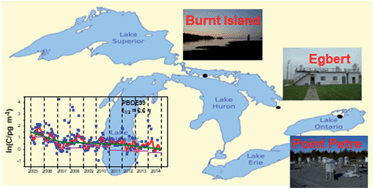Temporal trends of halogenated flame retardants in the atmosphere of the Canadian Great Lakes Basin (2005–2014)†
Abstract
Organic pollutants have been monitored in the atmosphere of the Great Lake Basin (GLB) since the 1990s in support of the Canada-US Great Lakes Water Quality Agreement and to determine the effectiveness of source reduction measures and factors influencing air concentrations. Air samples were collected between 2005 and 2014 at three sites with different geographical characteristics (Burnt Island, Egbert and Point Petre) in the Canadian GLB using high-volume air samplers and the air samples were analyzed for polybrominated diphenyl ethers (PBDEs) and several other non-PBDE halogenated flame retardants (HFRs). Spatial and temporal trends of total concentrations of HFRs were examined. BDE-47, BDE-99, and BDE-209 were the dominant PBDE congeners found at the three sites. For the non-PBDE HFRs, allyl 2,4,6-tribromophenyl ether (TBP-AE), hexabromobenzene (HBBz), pentabromotoluene (PBT), anti-dechlorane plus (anti-DDC-CO) and syn-dechlorane plus (syn-DDC-CO) were frequently detected. High atmospheric concentrations of PBDEs were found at the Egbert site with a larger population, while lower levels of PBDEs were detected at Point Petre, which is close to urban centers where control measures are in place. The strong temperature dependence of air concentrations indicates that volatilization from local sources influences atmospheric concentrations of BDE-28 and BDE-47 at Point Petre and Burnt Island, while long-range atmospheric transport (LRAT) was important for BDE-99. However, a weaker correlation was observed between air concentrations and ambient temperature for non-PBDE HFRs such as TBP-AE and HBBz. Atmospheric PBDE concentrations are decreasing slowly, with half-lives in the range of 2–16 years. Faster declining trends of PBDEs were observed at Point Petre rather than at Burnt Island. As Point Petre is closer to urban centers, faster declining trends may reflect the phase out of technical BDE mixtures in urban centers while LRAT influences the air concentrations at Burnt Island. The levels of syn-DDC-CO and anti-DDC-CO are decreasing at Point Petre and the levels of other non-PBDE HFRs such as TBP-AE, PBT and HBBz are increasing. Long-term declining trends of PBDEs suggest that regulatory efforts to reduce emissions to the GLB environment have been effective but that continuous measurements are required to gain a better understanding of the trends of emerging chemicals in the atmosphere of the GLB.

- This article is part of the themed collections: Best Papers 2018 – Environmental Science: Processes & Impacts, Best Papers from 2018 in the Environmental Science Family of Journals and Celebrating Excellence in Research: 100 Women of Chemistry


 Please wait while we load your content...
Please wait while we load your content...